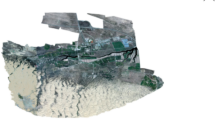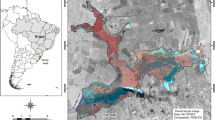Abstract
In order to better monitor and realize the vegetation of the ecosystem after the earthquake, and to provide reference for the rapid recovery of the ecological vegetation system after the earthquake, this paper discusses the vegetation planning and design and the dynamic monitoring method of the damaged vegetation restoration process in the earthquake-stricken areas. Based on the seismic disaster image and field investigation, the pine forest in L province was taken as the research area. The dynamic monitoring model of vegetation restoration process was established by using remote sensing technology. The vegetation restoration of different altitudes, slopes, and slopes was analyzed. The monitoring results show that 68.53% of the vegetation restoration effect is good. Vegetation restoration is mainly affected by altitude and slope gradient but less affected by aspect. The areas with better vegetation restoration are located in the sunny slope below 35° with an altitude of 1000–2000 M. Thus, the effective dynamic monitoring of the pine forest vegetation restoration process after the earthquake is realized.





Similar content being viewed by others
References
Alola AA, Alola UV (2018) Agricultural land usage and tourism impact on renewable energy consumption among coastline Mediterranean countries. Energ Environ 29(8):1438–1454
Cheng YW, Ng KH, Lam SS, Lim JW, Wongsakulphasatch S, Witoon T, Cheng CK (2019) Syngas from catalytic steam reforming of palm oil mill effluent: an optimization study. Int J Hydrog Energy 44(18):9220–9236
Colavito MM (2017) The role of science in the collaborative forest landscape recovery program. J For 115:34–42
Donders TH, Wagner F, Visscher H (2017) Quantification strategies for human-induced and natural hydrological changes in wetland vegetation, southern Florida, USA. Quat Res 64:333–342
Galidaki G, Zianis D, Gitas I, Radoglou K, Karathanassi V, Tsakiri–Strati M, Woodhouse I, Mallinis G (2017) Vegetation biomass estimation with remote sensing: focus on forest and other wooded land over the Mediterranean ecosystem. Int J Remote Sens 38:1940–1966
Hou YF, Li XH (2017) Landscape design in low carbon plant landscape scenery simulation degree evaluation. Compu Simu 8:12–14
Jiang S, Yan Z, Jing P, Li C, Zheng T, He J (2016) Relationships between sleep problems and psychiatric comorbidities among China’s Wenchuan earthquake survivors remaining in temporary housing camps. Front Psychol 7(1552)
Khoo SC, Phang XY, Ng CM, Lim KL, Lam SS, Ma NL (2019) Recent technologies for treatment and recycling of used disposable baby diapers. Process Saf Environ Prot 123(B):116–129
Laughlin DC, Strahan RT, Moore MM, Fulé PZ, Huffman DW, Covington WW (2017) The hierarchy of predictability in ecological recovery: are vegetation structure and functional diversity more predictable than community composition? J Appl Ecol 54:1058–1069
Liang F, Mao B (2019) Influencing factors of carbon reserve in natural ecosystem under spatial-temporal dynamic change. Ekoloji 28:2831–2841
Lin Y, Deng H, Du K et al (2017) Soil quality assessment in different climate zones of China’s Wenchuan earthquake affected region. Soil Tillage Res 165:315–324
Liu D, Fu L, Jing Z, Chen C (2016) Post-traumatic stress disorder and its predictors among Tibetan adolescents 3 years after the high-altitude earthquake in China. Arch Psychiatr Nurs 30(5):593–599
Lu WS, Li MN, Liang JQ (2019) On-line NBIoT sensing terminal for smart city transmission line monitoring. J CETC 14:86–89+96
Matsubara H, Ishikuro M, Kikuya M, Chida S, Hosoya M, Ono A, Kato N, Yokoya S, Tanaka T, Isojima T, Yamagata Z, Tanaka S, Kuriyama S, Kure S (2017) Design of the health examination survey on early childhood physical growth in the Great East Japan Earthquake affected areas. J Epidemiol 27:135–142
Osayemwenre GO, Meyer EL, Taziwa R (2018) Investigation of defects in crystalline silicon solar cells by confocal Raman spectroscopy. Energ Environ 29(8):1525–1533
Shi X, Wang F (2019) Analysis of the influencing factors of natural ecosystem maintenance on promoting outdoor aerobic exercise. Ekoloji 28:3015–3026
Thom D, Rammer W, Dirnböck T, Müller J, Kobler J, Katzensteiner K, Helm N, Seidl R (2017) The impacts of climate change and disturbance on spatio-temporal trajectories of biodiversity in a temperate forest landscape. J Appl Ecol 54:28–38
Urgenson LS, Ryan CM, Halpern CB et al (2017) Visions of recovery in fire-adapted forest landscapes: lessons from the collaborative forest landscape recovery program. Environ Manag 59:1–2
Wang H, Zhong H, Bo G (2018) Existing forms and changes of nitrogen inside of horizontal subsurface constructed wetlands. Environ Sci Pollut Res 25(1):771–781
Wei C, Jiang H, Moriya K et al (2017) Monitoring of post-fire forest regeneration under different recovery treatments based on ALOS/PALSAR data. New For 49:1–17
Widenfalk LA, Malmström A, Berg M et al (2017) Small-scale Collembola community composition in a pine forest soil. Soil Biol Biochem 103:52–62
Yang Y, Ping G, Li H (2017) Residents’ satisfaction to post-Wenchuan earthquake recovery and reconstruction. Nat Hazards 87:1–12
Yang XY, Dong WH, Lu J et al (2018) Effects of biochar on phytoplankton community in Iris wilsonii wetland. J Jilin Univ (Sci Ed) 1:184–189
Yin XM, Fan RZ, Lu ZX et al (2017) Preparation of dye sensitized solar cells based on phytochrome. CJPS 1:100–102
Yu H, Qiang M, Liu SQ (2019) Territorial suitability assessment and function zoning in the Jiuzhaigou earthquake-stricken area. J Mt Sci 16:195–206
Zhang JJ (2018) Design and analysis of dynamic monitoring system under high speed environment. Auto Inst 4:167–170
Author information
Authors and Affiliations
Corresponding author
Additional information
This article is part of the Topical Collection on Geological Modeling and Geospatial Data Analysis
Rights and permissions
About this article
Cite this article
Shao, Y. Planning and design of pine forest vegetation and dynamic monitoring method for recovery process in earthquake-stricken areas. Arab J Geosci 13, 895 (2020). https://doi.org/10.1007/s12517-020-05864-z
Received:
Accepted:
Published:
DOI: https://doi.org/10.1007/s12517-020-05864-z




